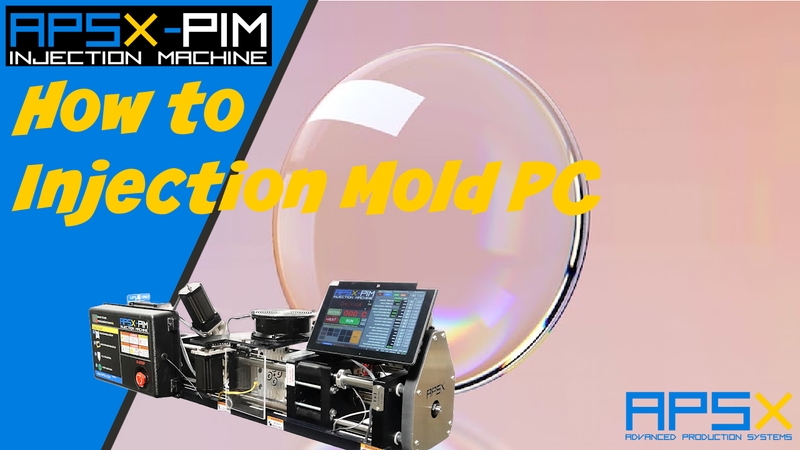Understanding and Overcoming Challenges in Polycarbonate Injection Molding
Polycarbonate, a versatile thermoplastic known for its transparency, and impact resistance, is used in various industries for manufacturing parts through injection molding processes. However, despite its advantageous properties, polycarbonate injection molding comes with its own set of challenges.

How to injection mold polycarbonate
Polycarbonate, a versatile thermoplastic known for its transparency, impact resistance, and thermal stability, is widely used in various industries for manufacturing parts and components through injection molding processes. However, despite its advantageous properties, polycarbonate injection molding comes with its own set of challenges. Understanding these challenges and implementing strategies to overcome them is crucial for successful and efficient production.
When using the APSX-PIM desktop injection molding machine for polycarbonate injection molding, here are some tailored suggestions that users might find beneficial:
Material Selection and Preparation:
- Polycarbonate Grade: Choose a polycarbonate grade optimized for injection molding, considering factors such as flow characteristics, heat stability, and impact resistance suitable for your intended application. The APSX-PIM can process low viscosity materials with MFR values higher than 15-20 in terms of ASTM D1238 standards with 1.2kg or 2.16kg weight.
- Drying Process: Ensure thorough drying of polycarbonate resin before injection to prevent moisture absorption, which can lead to defects like bubbles or surface imperfections. Follow manufacturer-recommended drying temperatures and durations. Ensure proper material handling and storage practices to prevent contamination and maintain material integrity.
Machine Settings and Operation:
- Injection Speed and Pressure: Due to its high viscosity when molten, polycarbonate might have difficulty filling intricate or thin-walled mold cavities. This results in incomplete part formation, leading to defects like voids or short shots. Experiment with injection speeds and pressures within the machine's capabilities to find the optimal parameters for your specific polycarbonate grade and part geometry. Start with moderate settings and adjust based on part quality. PC material likes to have high speed injection to complete it quickly. Conversely, excessive injection speeds might cause shearing or degradation of the polycarbonate material.
- Temperature Control: Utilize the APSX-PIM machine's precise temperature control features to maintain consistent mold temperatures throughout the process. Monitor and adjust temperatures to minimize thermal stresses and ensure proper material flow. The PC parts in general like to have hot molds (150C or higher).
- Insulator Usage: Consider using the PEEK insulator to facilitate minimum heat transfer from the nozzle plate to the mold itself. You can also control the duty cycle of the nozzle heaters by applying a certain percentage of heating activity.
Mold Design and Setup:
- Gate Design and Placement: Design appropriate gate sizes and locations based on the APSX-PIM's capabilities and your part requirements. Consider using larger gates to optimize the flow. Employing proper gating and venting techniques and utilizing mold flow analysis software can help identify potential flow issues before production. Ensure gate dimensions align with the requirements of the part and the chosen molding parameters.
- Runner System: Design the runner system to be as short and balanced as possible to minimize material waste, cycle times, and variations in part quality. Optimize runner sizes and layout to ensure uniform flow to all cavities. Design the runner system to minimize length while ensuring uniform flow and pressure distribution. Shorter runners reduce material waste, cycle times, and potential material degradation.
- Mold Design: Integrate suitable features like proper venting, smooth transitions, and adequate cooling channels to accommodate the desired injection speeds, gate sizes, and runner lengths effectively. A high gloss mold surface is always one of the best ways to have an easy and successful injection molding experience.
- Simulation and Analysis: Employ mold flow simulation software to analyze and optimize the runner layout, gate sizes, and injection speeds before actual production. This helps in predicting potential issues and optimizing the design early in the process.
Operational Best Practices:
- Use of Mold Release Agents: Employ suitable mold release agents to facilitate easy part ejection and reduce the risk of surface defects or sticking within the mold cavity.
- Thermal Degradation: Polycarbonate can degrade under high processing temperatures, causing issues like discoloration, reduced mechanical properties, or degradation of molecular structure, which affects part performance. Always start with low temperatures and gradually increase in the pilot run.
- Pilot Runs and Parameter Optimization: Conduct pilot runs and systematic parameter optimization tests using the APSX-PIM machine to determine the ideal settings for your specific polycarbonate molding needs. Record and analyze results to refine the process.
- Maintenance and Cleaning: Follow regular maintenance schedules outlined in the APSX-PIM machine's manual to ensure smooth operation. Clean the machine components, including the barrel, plunger, and nozzle, to prevent contamination and ensure consistent performance for CLEAR PART APPLICATIONS. Perform regular purging to prevent color contamination or other impurities that could affect clarity.
Continuous Improvement:
- Iterative Approach: Embrace an iterative approach to process optimization. Continuously fine-tune machine settings, mold design, and operational procedures based on feedback and observed results to achieve consistent high-quality parts.
By leveraging the capabilities of the APSX-PIM desktop injection molding machine and implementing these suggestions tailored for polycarbonate molding, users can enhance their production processes, optimize part quality, and achieve efficient and reliable manufacturing outcomes. Regular experimentation, data-driven decision-making, and adherence to best practices are key to success in polycarbonate injection molding using the APSX-PIM machine.
Conclusion:
Polycarbonate injection molding presents several challenges, primarily related to temperature sensitivity, flow characteristics, thermal degradation, and dimensional stability. However, with careful consideration of processing parameters, mold design, material handling, and advanced technologies, these challenges can be effectively addressed.